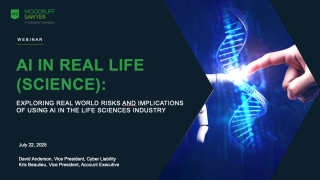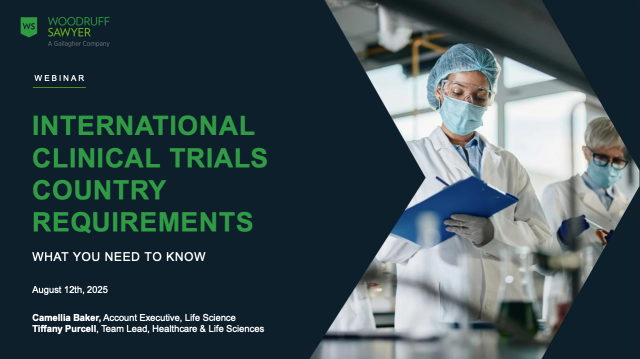Blog
Navigating Insurance for Artificial Intelligence and Life Science Products
Life science companies are tapping into artificial intelligence (AI) to improve how they work, transforming the way they handle data and approach product research and development. They’re using AI to speed up key processes like finding new drug candidates, running more efficient clinical trials, and monitoring side effects with greater accuracy.
Beyond drug development, AI is making everyday operations smoother by handling routine tasks, optimizing supply chain management, and even helping craft smarter marketing strategies. It’s also paving the way for more personalized treatments tailored to individual patients.
These advancements bring innovation and efficiency, but they also introduce risks.
This blog is adapted from a webinar, “AI In Real Life (Science): Exploring Real World Risks and Implications of Using AI in the Life Sciences Industry.” View the full webinar below or read on for an overview.
AI-Related Challenges and Risks
Although the use of AI enables companies to innovate faster, reduce costs, and improve patient outcomes, there are some challenges:
- Data Bias: AI models rely heavily on the quality of training data. If the data is biased or incomplete, it can lead to skewed outcomes, perpetuating inequalities in healthcare.
- Lack of Transparency: Many AI systems operate as "black boxes," making it difficult to understand how decisions are made. This lack of interpretability can be problematic in critical areas like diagnostics.
- Ethical Concerns: Issues such as patient privacy, consent, and the ethical use of AI in decision-making remain significant hurdles.
- Regulatory Challenges: The life sciences industry faces strict regulations, and integrating AI into workflows requires navigating complex compliance requirements.
Insurance for Artificial Intelligence: Tailored Solutions
AI is already being used in many industries, but insurance policies continue to be silent—or very unclear—around coverage for AI-related claims. Below, we’ll explore what to think about when it comes to AI risk and insurance coverage.
Product Liability
Life science companies using AI face heightened product liability risks due to issues like biased data and the difficulty in explaining AI decisions. If errors or failures lead to bodily injury or property damage, legal claims alleging things like product defects (both manufacturing and design) and inadequate warnings can follow. Misusing or failing to monitor AI technologies can lead to serious patient safety concerns and potential legal liability, due to risks such as errors, lack of oversight, and misuse.
Pure technology-related loss may be excluded, as human quality control is still necessary. If your product liability policy contains an exclusion for “integrity or availability of data” and you are using AI, it is likely not a good solution for your needs.
Professional Liability (Errors and Omissions)
Professional liability covers claims for monetary damages related to errors or negligence in the design or operation of AI systems or life science products.
If something goes wrong, the human practitioner is still responsible for delivering patient care, and they will be held personally responsible for the results. Additionally, there’s probably not going to be any recourse against the technology company that developed the AI within the current statutory frameworks.
Standard E&O policies do not cover bodily harm or property damage, but a specialized solution can if you work with the right broker.
Some policies have exclusions for liability arising out of a data breach or a cyberattack. Work with a knowledgeable broker to ensure that if that exclusion exists in your policy, it’s not so broad that it eliminates coverage that might have been included in a silent way.
Cyber and Data Breach Coverage
A cyber policy addresses risks tied to cyberattacks, data breaches, or system vulnerabilities. It can also be tailored to affirmatively cover (and fill gaps in) property damage and bodily harm arising from a cyberattack.
Your cyber insurance policy, if it is placed deliberately and carefully, should cover any unintentional data leakage into an AI model, or an employee accidentally uploading information into an AI model, or an AI vendor having a data breach of your patient or employee data on their platform.
Some cyber and technology professional liability insurance companies are starting to encourage clients to add AI-focused enhancements. Historically, AI has always been included in the definition of technology products and services. This is a broader definition that could be more favorable to our clients than an endorsement prescribing a specific list of covered claims. A knowledgeable broker can review the AI endorsements to ensure what’s being added to the policy doesn’t narrow the scope of coverage.
Directors & Officers (D&O) Liability
In life sciences, high risk means high reward and the D&O policy is the last line of defense from claims from creditors, shareholders, and other stakeholders. The use of AI introduces additional and complex risks that could potentially lead to regulatory investigations, shareholder lawsuits, and reputational damage. This directly impacts company boards of directors and highlights the critical need for robust D&O insurance coverage.
D&O insurers will likely want to know how and where you are using AI, and it will be important to show that your company is taking a balanced approach to AI adoption. This includes establishing clear AI usage policies, conducting thorough risk assessments, and ensuring transparent disclosures. By proactively implementing responsible and ethical AI guidelines, companies can mitigate potential D&O insurance claims related to AI technology.
Regulatory Compliance
As governments introduce stricter regulations for AI and biotechnology, companies face potential penalties and legal challenges. The regulatory risk around AI development, specifically in life sciences, is still evolving, and it may not always be insurable. There is little guidance on regulatory enforcement action, and the venue in which a regulatory claim is brought can affect insurability. Work with your insurance broker to ensure you have the most favorable language around venue and jurisdiction, and remove any potential problematic exclusions around deceptive trade practices for privacy, false advertising, collection, etc.
You’ll want to give yourself as much flexibility as possible to get coverage for regulatory claims related to AI. A cyber policy will cover privacy regulatory claims, but there’s uncertainty surrounding other regulatory claims. Having strong coverage from the start will make a big difference when you need to file a claim.
Watch the Risk Management for Your Life Sciences Company webinar series:
- Navigating Risk from Lab to IPO: A Guide to Insurance for Biotech Executives [On Demand]
- AI In Real Life (Science): Exploring Real World Risks and Implications of Using AI in the Life Sciences Industry [On Demand]
- International Clinical Trials Country Requirements: What You Need To Know [On Demand]
Looking Ahead
As AI and life sciences continue to evolve, the insurance industry must adapt to keep pace with emerging technologies and risks. Collaboration between insurers, insurance brokers, tech developers, and healthcare experts will be crucial in designing policies that safeguard innovation while fostering growth.
AI and life sciences risks are nuanced and require deep expertise and knowledge in cyber operational risk, data risks, and regulatory risks, among others. Work with a broker who knows your industry and your risks to help ensure you have coverage when you need it.
Learn more about AI and insurance for life sciences companies by viewing the entire webinar here. You can also register for other webinars in this series.
Authors
Table of Contents
















